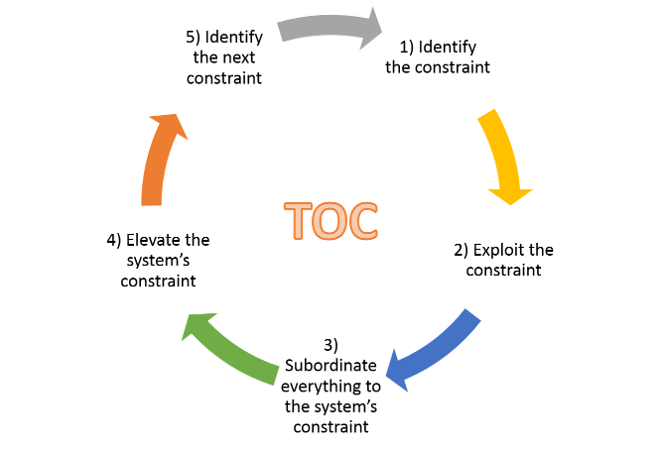Theory of Constraints
Focus improvement on the system's constraint.
"The performance of the system is determined by its weakest link." 1

Eliyahu Goldratt's Theory of Constraints (TOC) arose from manufacturing, but its relevance in Agile and knowledge work is even greater. At its heart, TOC asserts that every system is limited in achieving more of its goal by at least one constraint. Improving anything other than the constraint does not meaningfully increase overall throughput. In Agile settings, where the goal is often early and continuous delivery of valuable software, TOC helps teams focus improvement where it actually matters. Whether it's a single overloaded tester, a slow code review process, or a cross-team dependency, TOC shifts the conversation from "how do we go faster" to "what's in our way".
Agile coaches benefit from TOC because it provides a practical, systemic lens. It helps teams visualize the flow of work, confront the real bottlenecks, and avoid the trap of local optimization.
Impact on Agile Teams & Organizations
Constraints can exist at every level of an Agile system: individual roles, teams, departments, or even cultural norms. Addressing them transforms delivery and culture.
- System Flow Becomes Explicit
- TOC forces teams to visualize the end-to-end system, identifying handoffs, dependencies, and bottlenecks that are often ignored.
- Improvement Becomes Intentional
- Instead of scattershot efforts, TOC guides targeted improvement based on actual flow data.
- Team Autonomy is Respected
- Teams gain agency to address constraints within their control and elevate those beyond them.
- Cross-Functional Collaboration Increases
- When constraints span teams or silos, it encourages cross-team cooperation rather than blame.
- Performance Is Decoupled from Busyness
- Teams stop measuring productivity by effort and start measuring it by flow.
Scenario
A Scrum team consistently missing its Sprint Goals. They plan realistically, collaborate well, and have strong technical skills, yet throughput is stagnant. A Value Stream Mapping exercise reveals:
- All stories require UI/UX input, but only one designer is shared across five teams.
- Work sits idle in "Ready for Design" for multiple days per story.
- Developers either wait or overcommit to tasks they can start without design, creating rework later.
Instead of blaming the designer or asking developers to "just be more flexible", TOC reframes the situation. The designer is not the problem, they are the constraint. By managing the constraint, the system can improve.
Further systemic constraints often discovered include:
- Review queues from overloaded architects.
- Overlapping Sprint work across teams without shared priorities.
- A CI/CD pipeline with one failing step blocking all deployments.
- Management requiring sign-off on every minor release.
In each case, addressing the bottleneck, not working harder, improves overall delivery.
Ways to Mitigate
Agile coaches can introduce TOC with practical exercises like Value Stream Mapping, Flow Efficiency analysis, or Cumulative Flow Diagrams. Once constraints are visible, apply the five focusing steps.
Five Focusing Steps:
- Identify the Constraint
- Use visual boards, metrics, and team feedback to pinpoint flow-blockers.
- Examples: "Waiting on PO", "Blocked by Test", "Waiting for Approval"
- Use visual boards, metrics, and team feedback to pinpoint flow-blockers.
- Exploit the Constraint
- Ensure the constraint is not idle. Eliminate interruptions, clarify priorities, and offload non-essential work.
- Example: Shield the lone DevOps engineer from ad hoc tasks
- Ensure the constraint is not idle. Eliminate interruptions, clarify priorities, and offload non-essential work.
- Subordinate Everything Else
- Adjust the rest of the system to support the constraint.
- Developers finish work in priority order for testing.
- Review queues are cleared based on constraint availability.
- Adjust the rest of the system to support the constraint.
- Elevate the Constraint
- Add capacity, redesign roles, or automate to permanently relieve the pressure.
- Hire another tester or teach developers to write test scripts.
- Add capacity, redesign roles, or automate to permanently relieve the pressure.
- Repeat the Process
- Constraints are dynamic. Each fix shifts the pressure elsewhere. Improvement never ends.
TOC also advises against adding WIP when constraints are unresolved, it just builds inventory and hides the problem.
Conclusion:
The Theory of Constraints is a call to disciplined systems thinking. Agile teams often mistake symptoms (delays, rework, burnout) for causes. TOC brings clarity by forcing the question: What's the real limiting factor here? When used properly, it changes the culture from reactive firefighting to thoughtful, systemic flow management. In complex organizations, TOC also becomes a political tool—revealing misalignments between what's measured and what's valuable.
Key Takeaways for Agile Teams
- Every system has at least one constraint limiting performance.
- Improving anything other than the constraint yields minimal results.
- TOC provides a structured approach to identify and address bottlenecks.
- Constraints can be resources, policies, tools, roles, or even cultural norms.
- Agile coaches can use TOC to align improvement efforts across teams and silos.
- Solving one constraint will expose another, continuous improvement is ongoing.
Summary
The Theory of Constraints helps Agile organizations move from scattered improvement to focused flow optimization. It sharpens the Agile mindset by replacing local efficiency with systemic throughput, and it invites teams to challenge assumptions about capacity and value. In Agile contexts where dependencies, shared resources, and cognitive load are constant challenges, TOC remains a critical law that helps teams truly deliver more by doing less, but doing it smarter.